Interview ©2013
During the press trip organized by Czech Tourism New York last August our Rome Bureau Chief Lucy Gordan met with Borek Šípek in his recently-opened glassworks in Nový Bor, where he cooked a Thai meal for everyone. For the complete history of his fascinating career and images of his works, click on his website www.boreksipek.com.
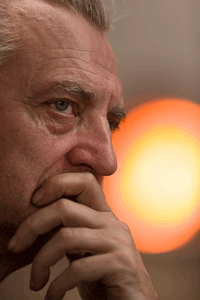
BOREK ŠÍPEK
You are a multi-faceted artist: architect, author, designer of furniture, of cutlery, of silverware, of light fixtures and chandeliers, of tableware, of glassware, of kitchen utensils, and you’re a glass artisan, who loves to cook and who even owned a Thai restaurant and a French bistro in the center of Prague. Do you think chefs are artists?
BS: Definitely. Cooking is a creative job; it is a composition of tastes and you can approach it in a very creative way. Also the way you serve your dishes, the way you decorate your food on a plate may be artistic.
Have you ever cooked professionally?
BS: No, never. I could not do it. In my opinion, being a chef is a stressful profession and you need other qualities besides creativity.
Our tastes in food are closely connected to our childhood; what are your first memories of food?
BS: My first memory is that I hated chocolate and that we ate lots of meatless traditional Czech meals, mainly made of potatoes. We ate meat only at weekends.
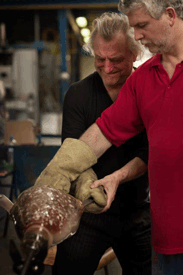
Šípek with one of his master glass-blowers
When did you start to love cooking?
BS: When I started to travel. Whenever I go abroad, I try the national local cuisine and guess what local ingredients it consists of. Later on I found out that it was extremely easy to improvise at cooking.
Who were your mentors in the kitchen and what did you learn from them?
BS: Life. Well, when I was a boy, I helped my father in the kitchen and started to be interested in cooking. My mother cooked as well but on weekdays. She cooked very well. I helped my father to prepare family meals on Saturday and Sunday when we had more time.
Outside of the kitchen, who were your artistic mentors and what did you learn from them?
BS: My professor of architecture in Hamburg, Jaap Bakema, Aldo van Eyck, Otto Rothmayer (even if I only met him for two afternoons). He told me a lot about architecture and opened my mind to perceive things from a different perspective.
What’s your culinary philosophy?
BS: I believe that food should not only taste and smell good, but it should also be served with care. An important aspect is to use only the best ingredients because the end result can be perfect only if the ingredients are perfect.
You lived in Thailand for several years and cooked us a Thai lunch, what are you specialties?
BS: I like improvising so nearly every meal I cook is an original which I make once and usually forget what exactly I put in there.
Many of your pieces of artistic works are connected to food and eating, like the light fixtures in the restaurant in Hiroshima; what is your favorite food to represent in glass?
BS: Fish
Tell me how you arrived at the idea of the table light fixtures/chandeliers in Hiroshima?
BS: I looked at the tables in bars to see what they look like when guests leave and the staff cleans up after them. I liked to invent little stories about the objects the clients left behind on their tables and made them out of glass. And I used the view or the atmosphere and put the tables upside down.
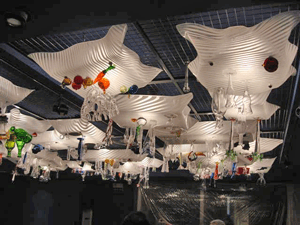
Light fixtures in Hiroshima fashioned to look like upside-down tables
Can you explain to my readers your passage from one artistic field to another?
BS: Architecture and design are very closed disciplines and one supports the other. They inspire each other. So it was a natural development from architecture to start being interested in design. Both are equally important for me.
As a Renaissance Man of art and cuisine, which of your several professions have given you the greatest satisfaction and why? From your website it seems to be architecture more than design.
BS: Currently I am happy I have my glass studio and I mainly focus on designing glass objects, but I do architecture as well. And the satisfaction that both professions bring me is very similar. The completion of anything you start doing is satisfactory, especially if you know you have done your best.
There are pictures here, on a wall of your new glassworks, of most of the famous buildings you’ve designed, can you tell my readers where they are?
BS: In many different parts of the world. Some in Germany, the Netherlands, Japan, China, and of course the Czech Republic.
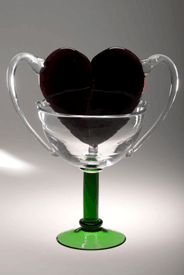
Glass from the Havel collection
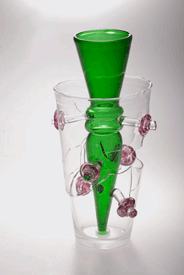
Do you have a favorite among all your works-of-art?
BS: It is difficult to say; I can’t think of any one piece.
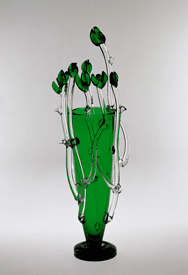
Šípek’s best sellers
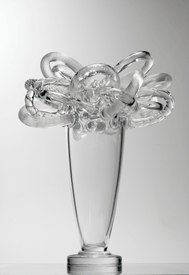
Šípek’s best sellers
You were a long-term friend of President Václav Havel who inspired many of your glass artworks; what was he like in person?
BS: He initiated lots of things. I made gifts for official visits. For instance Hillary Clinton, Mick Jagger, Robert Redford and many others received my works as gifts from Havel. But to get back to his personality, he was very modest, thoughtful, interested in many things — public affairs, politics, human rights and also art, literature. He respected other people’s opinions, tried to consider different views on important things; he was an outstanding man.
You have galleries in Prague, Amsterdam, and Shanghai; how do the tastes of your international clients vary from country to country? What are your bestsellers?
BS: There are no big differences between different countries. People want to buy my things because they like my style. Of course there are some bestsellers, but they are bestsellers everywhere. It much more depends on the perception of particular people than on a national taste. My most popular pieces all over the world, my best sellers if you want, are “Chevori Vori” and “Vrabcova”.
Up to now you’ve told me about Borek Šípek the professional; I’d like to know more about Borek Šípek the person. For example, what are your favorite foods?
BS: I am stubborn, a workaholic and I love food — fish, seafood, truffles. In fact apart from chocolate I eat everything.
If you were in jail, on Death Row, what would you order as your last meal?
BS: I don’t think I would think about food. I would rather look back upon my life, what I have done well and what I’ve done badly.
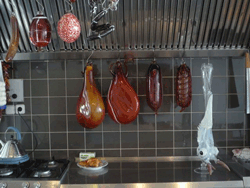
Kitchen art glass
A dish you dislike?
BS: Chocolate.
Your favorite wines?
BS: Sauvignon Blanc and Chablis.
Other favorite beverages?
BS: Green tea.
A favorite dessert?
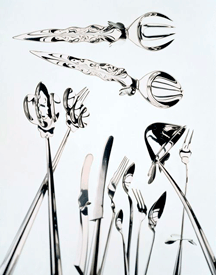
Šípek’s glass utensils
BS: Cheese.
Your favorite color, flower?
BS: Violet and tulips.
What zodiac sign are you?
BS: Gemini.
What is never missing in your home refrigerator?
BS: Anchovy paste.
What cuisine besides Thai is your favorite?
BS: Italian, Cantonese, Indian.
Your favorite artist and why?
BS: I don’t like to answer this type of question as it is so difficult not to forget about all I appreciate. What I am interested in is the diversity and vast variation you can find in art. So I am not particularly interested in one or a few artists; I also keep looking for new ones. There are also so many art disciplines, which makes it even more difficult to single out just a few artists.
Your favorite works of art?
BS: The same as for the artists.
How many languages do you speak?
BS: Czech, German, Dutch, English, and I understand French and a little bit of Italian.
Do you collect anything, if so what?
BS: Hens and ritual masks. The hens are very different, made of different materials. Some are pieces of art and some are just ordinary objects. It all started when I bought a bowl in the shape of a hen in Thailand. Since then I have collected probably more than two hundred hens. They have their own room, which they “share” with the masks. The masks are from Oceania and a few are from Africa.
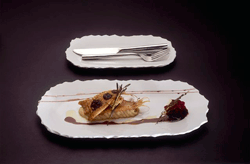
You are a world-famous artist, who has lived for long periods in Germany and Thailand, where you worked for the Italian design company Driade; how often have you been to Italy?
BS: Many times. First my co-operation with Driade was quite intensive; second I have visited “Salone del Mobile” nearly every year; and third I like Italy and Italian culture a lot so I welcome every opportunity to go there. And I forgot to mention my partnership in Alterego so I spent more time in Florence for instance. As I cooperate with other Italian companies, sometimes I go there ten times a year.
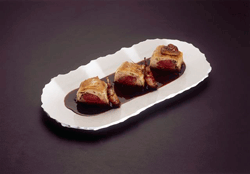
Since many of my readers are Italian, do you have artworks in Italy? If so, where?
BS: Probably yes, but I don’t know where.
Do you have a favorite place in Italy and why?
BS: Rome — the Pantheon, it is very impressive and you feel the history passing by; Sicily for its lovely nature, sunny weather and excellent cuisine; Venice for its architecture and cultural and artistic life, probably the whole area of Tuscany. All the places are beautiful and pleasant to visit.
A favorite Italian dish?
BS: Anything with white truffles, riso nero and vitello tonnato.
A favorite restaurant in Italy?
BS: There is a small restaurant in the old town in Rome just for few people but I don’t know its name. And Harry’s Bar in Venice.
Where do you like to go on vacation?
BS: Asia, I like the culture. I know Thailand quite well and the people are very friendly, polite, and humble. I also like Japan. It’s a very polite and well-organized country. The Japanese are so generous to their guests.
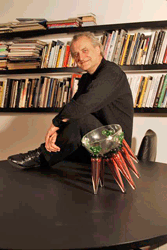
The Italian design firm Driade seems to have put you on the artistic world map. How did you make contact with it and how long did you work for it?
BS: I have worked for them for more than 25 years. I met Driade people in Germany at an exhibition and we started to work together. And it has always been pleasant, at least for me.
If you hadn’t become an architect, designer, restaurant owner, and glass artisan, what other profession would you have chosen and why?
BS: Probably a cook, as cooking is my hobby and is creative, but also a full-time architect and designer.
& & &
